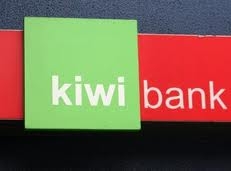
By Gareth Vaughan
Kiwibank needs about another NZ$200 million of capital over the next four years before it'll be self sustaining and in a position to pay dividends, say analysts at First NZ Capital.
Based on this analysis, that would make Kiwibank a self sustaining business paying dividends around 14 years after it opened in February 2002 at a cost of about NZ$829 million, based on total equity on Kiwibank's balance sheet now of NZ$628.986 million plus the additional NZ$200 million.
Kiwibank's NZ$628.986 million of equity includes NZ$478.986 million attributable to taxpayers as the ultimate owners of Kiwibank's parent New Zealand Post, plus NZ$150 million stemming from last year's preference share issue. Interest.co.nz's trading bank leverage summary shows Kiwibank's total assets exceed shareholder investment by 23.4 times, the highest of any of the major banks at September 30.
The state owned bank was controversially set up as a subsidiary of NZ Post with an initial NZ$83 million of taxpayers' money. Its establishment came after then Alliance leader Jim Anderton pledged a New Zealand-owned bank with a national branch network providing services for low-and middle income earners during the 1999 election campaign.
The analysis from First NZ Capital research analysts Kar Yue Yeo and Jason Familton comes in a report on the New Zealand Post Group included in the Annual Portfolio Report put together by Treasury’s Crown Ownership Monitoring Unit.
Asset growth & earnings forecast imply another NZ$200 mln is needed
The First NZ Capital report estimates Kiwibank's operating earnings will rise to NZ$175.7 million in 2014 from NZ$55.9 million this year, with its net profit after tax up to NZ$109.5 million from just NZ$21.2 million this year, which more than halved from last year's NZ$45.8 million as provisions for bad debts surged. The analysts see interest bearing asset growth of NZ$1.7 billion in the year to June 2012, up from NZ$1.59 billion this year, rising to NZ$2.1 billion in 2014.
They see Kiwibank's net interest margin rising from 1.48% this year to 1.67% in 2014, still well shy of the latest 2.37% estimate the Reserve Bank puts on the combined net interest margin of all retail focused retail banks.
"Our asset growth and earnings forecasts for Kiwibank imply that the company requires an additional capital injection of around NZ$200 million (split between equity and subordinated debt) spread over the next four years before the bank becomes self sustaining," the First NZ analysts say. "We forecast Kiwibank to commence dividends payments in full-year 2016."
'In full-year 2016 and beyond, we assume Kiwibank becomes self-funding for growth and is able to start paying dividends. We assume NZ Post in turn pays this out to the Crown together with 50% of non-Kiwibank earnings."
They also note Kiwibank's cash return on equity (RoE) fell to just 1.2% in the June 2011 year, from 7.5% the previous year and a high of 15.7% in 2009. They see RoE reaching 12% in 2014.
NZ$300 mln backstop for an 'unforeseen event'
The government last year earmarked NZ$300 million of taxpayers' money for an "uncalled capital facility" for NZ Post to help maintain its credit rating and Kiwibank's growth. This facility can be called upon in response to a "significant unforeseen event."
Kiwibank's founding CEO Sam Knowles, who quit the bank last September, said when announcing his departure the bank had the potential to grow further and faster over the next decade than it had in its first eight years, but this would require its Government shareholder to forsake dividends. As of September 30 this year, Kiwibank had total assets of NZ$14.7 billion and total liabilities of NZ$14.1 billion.
Meanwhile, the First NZ Capital analysts note Kiwibank has historically grown lending at a faster pace than system credit growth through gaining market share in the residential mortgage market. Their calculations assume Kiwibank continues growing its share in the housing market at 75 basis points per annum over the next decade.
'NZ$200 mln of annual profit'
A second report on NZ Post, by Macquarie analysts Stephen Hudson and Warren Doak, predicts Kiwibank will start paying dividends from 2017 with a payout ratio of 30.9% of profit, giving a 4.1% yield. Hudson and Doak's forecasts stretch out as far as 2020, at which point they estimate Kiwibank will deliver NZ$200 million in net profit after tax, have total assets of NZ$29.3 billion and total loans of NZ$26.9 billion, more than double the NZ$11.8 billion it had at September 30.
Macquarie's Hudson and Doak place a sum-of-the-parts equity valuation on NZ Post of NZ$907 million, with Kiwibank comprising NZ$779 million of this. That's down from their valuations a year earlier of NZ$1.356 billion for NZ Post and NZ$995 million for Kiwibank.
The First NZ analysts value Kiwibank on an equity basis, excluding its preference shares, of NZ$806 million, which is down from NZ$853 million a year earlier. They value NZ Post at NZ$1.062 billion, up from NZ$1.056 billion due to a reduction in debt.
This article was first published in our email for paid subscribers this morning. See here for more details and to subscribe.

We welcome your comments below. If you are not already registered, please register to comment.
Remember we welcome robust, respectful and insightful debate. We don't welcome abusive or defamatory comments and will de-register those repeatedly making such comments. Our current comment policy is here.